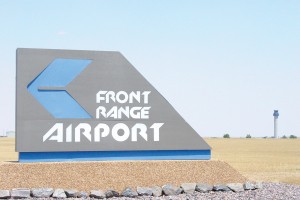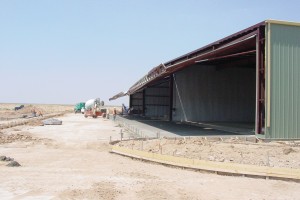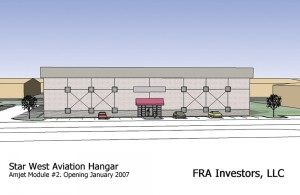By S. Clayton Moore
There’s a party coming to Front Range Airport (FTG), one of the Denver metro area’s fastest-growing aviation facilities. On August 9 at 4 p.m., the airport will be celebrating the opening of its new 48-acre business jet module with lots of local luminaries and airport officials, and lots of fanfare.

Tina Fiorini (left) and Michael Buehner-Coldrey show off the Fiorini Hangar, a new 27,000-square-foot hangar that will open the new business jet module at Front Range Airport.
The festivities will include a ribbon-cutting ceremony for a cutting-edge 27,000-square-foot hangar, the first facility to be built on the module. Amjet LLC is a new enterprise constructed by the airport’s business visionaries, Captain Michael Buehner-Coldrey (known throughout the Front Range Airport community as Michael B.C.) and his wife Tina Fiorini.
After the ribbon-cutting, guests will march alongside a genuine British pipe-and-drum band to the groundbreaking of a new 29,000-square-foot hangar. Eventually, the new business jet module will accommodate up to five lanes of jet hangars, all outfitted with concrete taxi lanes and many other amenities.
“The business jet module is a keystone for accelerated growth at this airport,” said Dennis Heap, director of aviation at Front Range Airport. “This is the most critical module because of its ability to support large aircraft, which will drive business to Front Range Airport.”
The opening of the business jet module, also known as Module Two, is just one of a number of new developments that are rapidly accelerating the airport’s growth. The 4,000-acre airport facility has huge potential—it’s large enough to fit both Jeffco and Centennial Airports within its boundaries—and its new developments are the culmination of years of hard work out on the eastern plains.
One of the most significant additions has been the airport’s new $5.7 million air traffic control tower, which became fully operational a year ago. It’s the tallest general aviation tower in the United States and demonstrates a significant commitment to the facility by Adams County and the dedicated professionals who manage the growing airport.
“The air traffic control tower is definitely tied into the new module,” Heap explained. “When the airport looked at developing nearly 50 acres, we had to meet certain requirements, including infrastructure and a control tower. If you’re going to build facilities for big airplanes, a certain number of operators won’t fly in here unless you have positive control. Those two things are linked.”
For years, the airport has been working with the Schuck Corporation and the Union-Pacific transportation company to develop an intermodal hub called TransPort. It will integrate air, rail and truck transportation into the aviation facility. Now that the infrastructure and amenities at Front Range are becoming more concrete, the reality of that goal looms closer and closer.
Michael Buehner-Coldrey first came to the airport for a meeting of the Confederate Air Force and fell in love with the friendly aviation community here. A former RAF and British Airways pilot, he’s been committed to the airport ever since. In 2003, he opened “Big Blue,” a 34,000-square-foot hangar named in honor of his late wife, Jaye Buehner-Coldrey, who was a lifelong employee at IBM. As advertised, the hangar is painted bright blue, a scheme which didn’t go over well at first with the airport authorities.
“I told them, ‘You guys are entering a new phase. There’s nothing wrong with the old way, but you have to turn a chapter,'” he said.

The most significant addition to Front Range Airport’s infrastructure has been its new aircraft control tower, the largest general aviation tower in the United States.
The big blue hangar certainly hasn’t hurt business here. Recently, Aviation Technology Group, the manufacturer of the Javelin very light jet, announced its decision to open a manufacturing facility at Front Range. While the company had considered remaining at Centennial Airport and its facilities in New Mexico and Utah, it found the right landing spot for its new manufacturing facilities in the good hands of Michael Buehner-Coldrey and Tina Fiorini.
“At the beginning of January, ATG is taking over Big Blue in its entirety,” Buehner-Coldrey said. “It came about when ATG approached the airport when it was selecting its assembly space. It was a great team effort that put the project together, and it really bodes well for the future of the airport.”
ATG will lease two hangars at the airport. ATG flight operations will use an adjacent 21,000-square-foot hangar as its test facility headquarters and Big Blue will be used for the full-scale production of as many as 10 Javelins at a time.
“We were very thorough in our site selection process, working with many states around the country,” said George Bye, chairman and CEO of ATG. “Front Range offered availability of space and superior airport facilities that helped us make our decision.”
However, Buehner-Coldrey and Fiorini still have plenty of current tenants in Big Blue that need a home come wintertime, which precipitated a need to build more hangars. Amjet currently holds a 70-year master lease on Module Two, which it had acquired from Jetport, LLC in 2001 in a lightning-fast deal.
“This window of opportunity came up with literally seven days’ time to decide whether to take on this lease,” Buehner-Coldrey remembered. “That’s how Amjet was born.”
The new Fiorini Hangar is intended for midsized business jets, but FTG extended the acreage along the northern line of Module Two to allow for larger categories of aircraft in the future, such as Boeing 737s. The condominium hangar has six units and has many unusual amenities, such as a 70-foot-wide, hydraulically-operated door.
“We wanted to be innovative in this module, and I like doing new things with these projects,” Buehner-Coldrey explained. “A lot of this technology has been around for a long time, but nobody’s been taking advantage of it.”
The facilities at Front Range also differ from their counterparts at other local airports in that Amjet, working in conjunction with airport authorities, has been able to plan out its development and pay strict attention to important details like security.
“We’ve planned this all along,” Buehner-Coldrey said. “We’re fortunate in that respect. We’re able to build in eight-foot-high security fencing without waiting for Homeland Security to mandate it or waiting for federal dollars.”

Amjet purposefully designed the Fiorini Hangar with 70-foot-wide doors to accommodate larger business jets.
Amjet will also start construction almost immediately on the second adjacent hangar. It will eventually total 29,000 square feet and use many of the same innovative construction techniques as Big Blue and the Fiorini Hangar. The company is also in the planning stages for a third 27,000-square-foot hangar. Eventually, this premier airside property is slated to accommodate nearly 30 sites totaling 503,000 square feet of hangar space.
The new hangar to be completed in December will be home to Star West Aviation, a new Part 135 charter service founded by Bill Ebert, a current United Airlines captain. It encompasses charter and cargo operations as well as a small flight school, utilizing twin-engine Piper Chieftains.
“Barring any problems, we’ll be putting a spade in the ground in August,” Buehner-Coldrey said. “Star West has this guillotine deadline, but they want better exposure and a nice, customer-friendly building anyway. We’ve already ordered the building and have FAA approval to build it.”
With the remainder of Module Two, Amjet is taking an innovative approach. While it would be easy for its developers to build a series of cookie-cutter hangars to maximize the remaining acreage, Buehner-Coldrey and Fiorini are being as flexible as possible to attract and accommodate business and corporate operators to the airport.
“We’re trying to please the customer, as you have to do in the modern age,” Buehner-Coldrey said. “To make that possible, we’re trying not to make the business jet module site-specific any more than we have to. We want the customer to be able to come along and say, ‘I want a hangar in this size with this shape,’ and we want to be able to accommodate them with an appropriate plot of land. Obviously, there will come a time when we’ll have to fill in the empty spaces, but within reason, we’re being as flexible as possible.”
Jehn Engineering, led by founder Joseph Jehn and headquartered in Arvada, Colo., is constructing the new hangar. Citywide Banks provided the construction financing for the site’s infrastructure, providing about $2.6 million in capital infrastructure costs alone.
Amjet also holds the right of refusal for a second business jet module, Module Four, an adjacent parcel just west of the new business jet module. Its development will be funded through a new company whose partners include Buehner-Coldrey, Fiorini, Jehn, Hagan Brothers General Contractors and Tom Molin, representing Primus Contracting Group.
“We’re sharing the risks with those gentlemen,” Buehner-Coldrey said. “Because of those increased resources, we can really get on a roll with these hangars. We envision a similar module to this one. These projects make sure that as the airport grows, we can accommodate that growth.”
Buehner-Coldrey praises everyone who has worked to bring Module Two to fruition, including Adams County’s government officials and the dedicated team at Front Range Airport with whom he works every day.
“One of the things that work really well at this airport is the partnership between the public sector and the private sector,” he said. “It’s not like the airport is building all these modules to attract business to Front Range Airport. It’s private, commercial entities that are buying into this location and believe in it. That’s an important factor, and it’s one of the real strengths of this airport.”

This drawing by Jehn Engineering envisions Amjet’s new 29,000-square-foot hangar, which will be occupied by Star West Aviation.
Soon Excel Energy will begin construction of a power substation that will bring the airport up to full commercial levels. With the completion of the control tower at Front Range, the recent extension of 56th Avenue, which provides a more direct route to Denver International Airport, and now the generation of significant facilities for business and corporate aircraft, Heap says the airport’s momentum is at its highest.
“These are drivers,” he explained. “As we start to get more large aircraft using this airport and get our operational numbers up, it drives federal dollars. Hopefully, we get some operators wanting longer runways, and then we can extend our two 8,000-foot runways even further. It puts us closer and closer to doing cargo.”
Another advantage of the growing airport is its robust airport influence zone, prohibiting commercial and residential developments from coming close enough to impede the dramatic growth at Front Range. To attract businesses like ATG, the Adams County government has also wisely extended its enterprise zone around the entire facility, offering incentives to businesses that relocate to Front Range Airport.
“If you’re in the corporate world, and you want to come operate at Front Range Airport, the prices here are competitive with anywhere else in the region,” Buehner-Coldrey said. “Having not been on a level playing field with Jeffco and Centennial for a long time, we feel we’re really ahead of the game these days.”
Plans to eventually transition Front Range into a major multimodal cargo hub are still very much in the works, and these new developments demonstrate that the airport is ready for its future evolution.
“The tower was a big deal,” Heap observed. “Fifty-Sixth Avenue was a big deal, and now this business jet module is a big deal. ATG represents a major step. The hangar development is the key. It says that this airport is ready and committed to cargo, business and corporate traffic. Now you’re seeing bigger companies with more employees here and they keep spinning off more and more business.”
While the airport, located near sleepy Watkins, Colo., hasn’t always gotten the attention given to busier airports in the region, the committed backers of Front Range believe that’s all about to change.
“People don’t realize that this airport started 20 years after Centennial and Jeffco,” Heap said. “While it may seem a long way out here today, it won’t be a long way in 20 years, as this area and this airport continue to grow. I think this airport will eventually surpass even Centennial economically, because of the multimodal aspects of this facility.”
Now, though, it’s time to step back and appreciate what these dedicated professionals have accomplished. Buehner-Coldrey says that this month’s celebration meshes well with the philosophy he developed while flying jets for England’s Royal Air Force, which he joined at 16.
“I always learned that you work hard and you play hard, in that order,” he said. “Everyone is working very hard right now to achieve a lot of things, but you have to be able to step back and have some fun as well. That’s what we’re planning on August 9. Front Range is open for business, and we’re all very pleased.”
For directions to the celebration to be held August 9 at Amjet’s new Fiorini Hangar, visit [http://www.ftg-airport.com/airport_maps.php]. For more information about Amjet’s hangar facilities, visit [http://www.amjet2.com].











